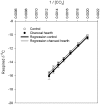Carbon sequestration and fertility after centennial time scale incorporation of charcoal into soil
- PMID: 24614647
- PMCID: PMC3948733
- DOI: 10.1371/journal.pone.0091114
Carbon sequestration and fertility after centennial time scale incorporation of charcoal into soil
Abstract
The addition of pyrogenic carbon (C) in the soil is considered a potential strategy to achieve direct C sequestration and potential reduction of non-CO2 greenhouse gas emissions. In this paper, we investigated the long term effects of charcoal addition on C sequestration and soil physico-chemical properties by studying a series of abandoned charcoal hearths in the Eastern Alps of Italy established in the XIX century. This natural setting can be seen as an analogue of a deliberate experiment with replications. Carbon sequestration was assessed indirectly by comparing the amount of pyrogenic C present in the hearths (23.3±4.7 kg C m(-2)) with the estimated amount of charcoal that was left on the soil after the carbonization (29.3±5.1 kg C m(-2)). After taking into account uncertainty associated with parameters' estimation, we were able to conclude that 80±21% of the C originally added to the soil via charcoal can still be found there and that charcoal has an overall Mean Residence Time of 650±139 years, thus supporting the view that charcoal incorporation is an effective way to sequester atmospheric CO2. We also observed an overall change in the physical properties (hydrophobicity and bulk density) of charcoal hearth soils and an accumulation of nutrients compared to the adjacent soil without charcoal. We caution, however, that our site-specific results should not be generalized without further study.
Conflict of interest statement
Figures





References
-
- Lehmann J, Gaunt J, Rondon M (2006) Bio-char Sequestration in Terrestrial Ecosystems – A Review. Mitigation and Adaptation Strategies for Global Change 11: 395–419. Available: http://link.springer.com/10.1007/s11027-005-9006-5. Accessed 23 May 2013. - DOI
-
- Laird DA (2008) The Charcoal Vision: A Win–Win–Win Scenario for Simultaneously Producing Bioenergy, Permanently Sequestering Carbon, while Improving Soil and Water Quality. doi:10.2134/agronj2007.0161.
-
- Woolf D, Amonette JE, Street-Perrott FA, Lehmann J, Joseph S (2010) Sustainable biochar to mitigate global climate change. Nature communications 1: 56. Available: http://www.pubmedcentral.nih.gov/articlerender.fcgi?artid=2964457&tool=p.... Accessed 29 May 2013. - PMC - PubMed
-
- Joseph SD, Downie A, Munroe P, Crosky A, Lehmann J (2007) Biochar for Carbon Sequestration, Reduction of Greenhouse Gas Emissions and Enhancement of Soil Fertility; A Review of the Materials Science: 130–133.
-
- Yanai Y, Toyota K, Okazaki M (2007) Effects of charcoal addition on N 2 O emissions from soil resulting from rewetting air-dried soil in short-term laboratory experiments. Soil Science and Plant Nutrition 53: 181–188. Available: http://www.tandfonline.com/doi/abs/10.1111/j.1747-0765.2007.00123.x. Accessed 28 May 2013. - DOI
Publication types
MeSH terms
Substances
LinkOut - more resources
Full Text Sources
Other Literature Sources

